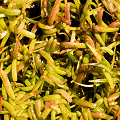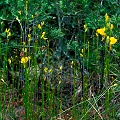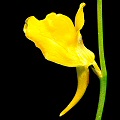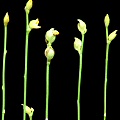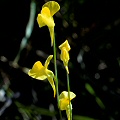| Utricularia section Stomoisia | ||
|---|---|---|
| Species | Range | Habit1 |
| U. cornuta | North America, Central America | T/SAA/L |
| U. juncea | North America to South America | T/SAA |
| 1T=terrestrial; SAA=subaffixed aquatic; L=lithophyte. | ||
Q: About Utricularia subgenus Bivalvaria section Stomoisia
A: After the strangeness of section Phyllaria, of which I have no
practical experience, it is a pleasure to return to something more familiar like this section!
These species are very similar to section Oligocista species in terms of their flowers, but details such
as the pollen shape merit a separate section. For some basics on growing these plants, refer to
this article on U. gibba. Those techniques will be successful
with these species.
Utricularia cornuta
This species occurs throughout much of the USA east of the Mississippi
river, and even a bit west of the river, too. It has large
flowers that are clustered near the top of the inflorescence, and flowers from midwinter (in warm climates) to early-mid summer.
I list this as sometimes being an epiphyte as I have seen it growing as such on the great escarpment balds of South Carolina.
While my cultivated plants have acute leaf tipes, I have seen wild plants with very rounded leaf tips.
There is no doubt that at times, there are plants that look intermediate in one or more characters between this and the following
species, but usually there is not much difficulty in separating the two if they are in flower. Out of flower, all experts agree that
the plants cannot be separated.
Utricularia juncea
This species is much like a smaller-flowering version of
U. cornuta. Within the USA, it is restricted to (mostly) coastal eastern states.
Outside the USA, it occurs in the Caribbean, Central America, and much of South
America.
The flowers are smaller than those of U. cornuta, and are scattered along the inflorescence axis.
Often, the flowers are so reduced in size they are actually cleistogamous---making identification a piece of cake. (Such plants
have sometimes been called U. virgatula.) These plants flower in late fall.
Page citations: Rice, B.A. 1994b, 2006a; Taylor, P. 1989; personal observations.
